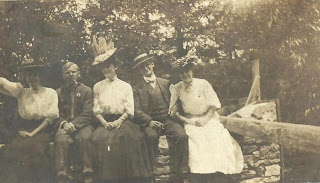My post on women's dress and its sexual interpretations yesterday got mired in that ocean of fatigue, I think, so I will try again. The points I wish to make are these:
1. None of us ever completely independently choose what to wear. The culture (into which I put religion) affects our choices, the existing technologies affect our choices and the responses our dress receives also affect our choices. Most importantly, what others expect us to wear affects our choices.
Take, for example, these pictures: If you lived in a society where people dress like this, how would you, personally dress?


It's pretty clear to me that our ultimate choices are strongly influenced by the general society. To simply make that into individual choice is problematic, though some choice naturally exists.
2. But how much choice women, in particular, have, varies widely. Some women have no choice at all (women in certain fundamentalist and tribal societies), some women have almost complete choice (say, Lady Gaga or Madonna). What I mean by these end-points are the costs of choosing "wrong." A famous singer or actor, one with plenty of money, can dress in anything or nothing as she pleases without punishment. At the other extreme, a woman in some parts of Afghanistan may get killed if she goes out without wearing a burqa.
But most of us are situated somewhere along the middle, with nothing major happening if we pick the 'wrong' kind of clothes. This does not mean that the choices are then without any positive or negative consequences. Clothing speaks, whether we wish it to do so or not, and, sadly, the way it speaks doesn't depend solely on what we intend it to say. It's the interpretation of others which matters here.
3. Historically, the rules about women's dress have always emphasized gender, beginning from the Biblical statement telling people not to cross-dress. If you go away with one conclusion from looking at pictures in a book about clothes through the ages it is that people have always really, really wanted women to dress differently from men. To be visibly women. And in many cases this has meant that women's clothing has been more cumbersome, more restrictive and even more dangerous than the clothes men have been allowed. Long dresses in kitchens with open fire are not safe, for example. Even though the Western dress codes no longer require that women wear dresses/skirts and men wear trousers, understanding the history is still relevant because shreds of it still swim in our consciousness and because these codes are much stronger in other cultures.
4. The most important determinant of 'appropriateness' in women's dress has always been what it tells about her sexual availability. The male gaze, if you wish, though with layers of complications.
In many cultures married women have historically dressed differently from unmarried women, to reflect their changed status in terms of possible sexual availability, and prostitutes have traditionally been expected to dress in a way which demonstrates their willingness to engage in market transactions. Given this expectation, women who are not willing to engage in market transactions had to then express that unwillingness in their dress by not wearing certain items of clothing. Veiling, I've been told, developed from a desire to tell free (higher class) women apart from slaves (who were not allowed to veil and couldn't refuse sex).
These aspects are still very much alive, though somewhat more nuanced in our culture. My previous post discussed the way a woman's dress is still interpreted as telling about her sexual availability, both in the come-hither sense and in the sense of labeling women who don't cover up as sluts. We need to address that aspect much more strongly in the general debate that is now going about the burqa ban in France and in discussions about sexual harassment.